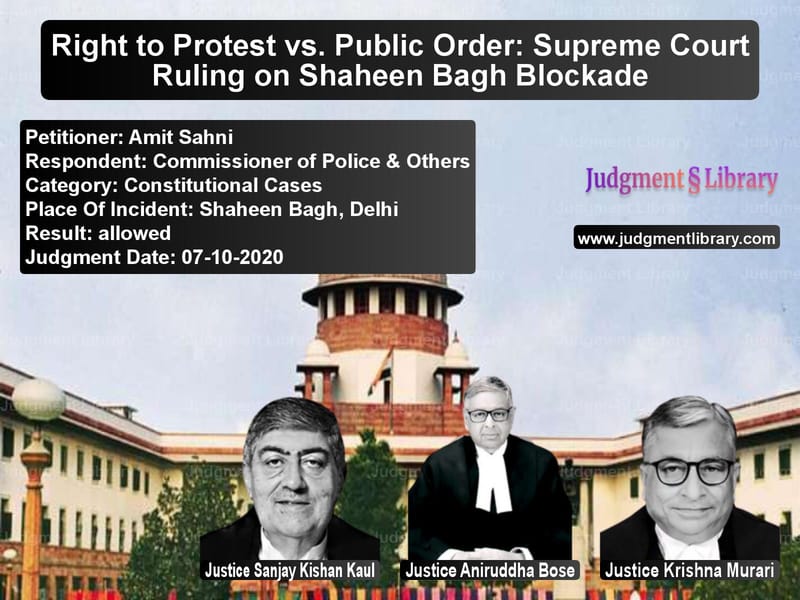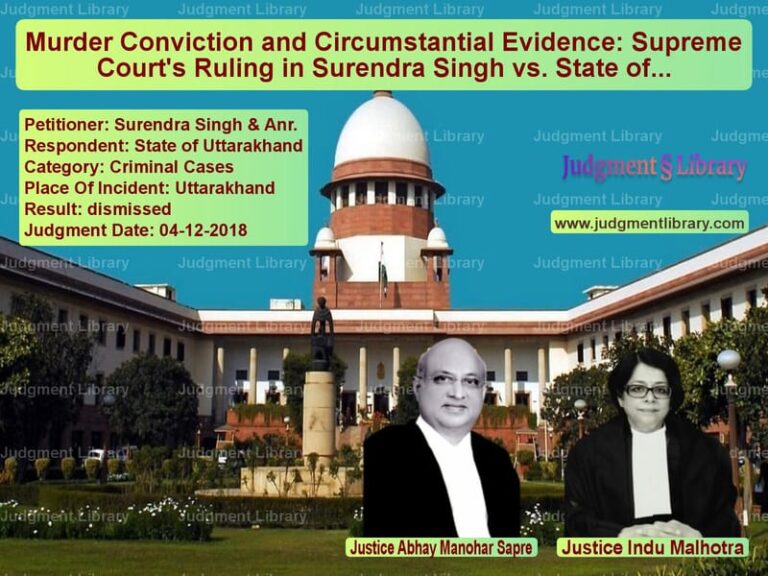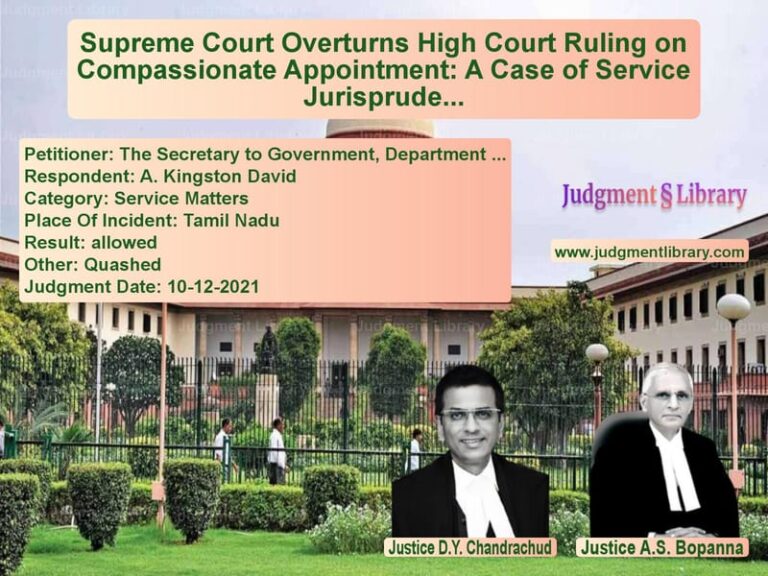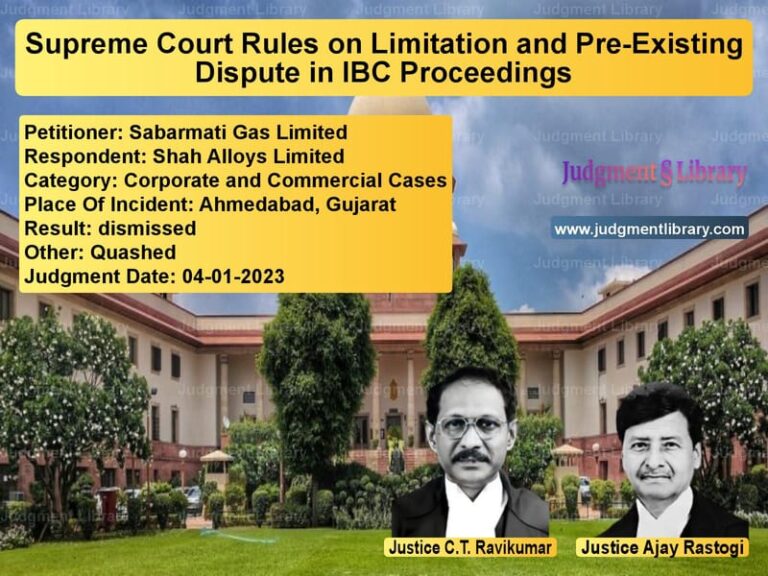Right to Protest vs. Public Order: Supreme Court Ruling on Shaheen Bagh Blockade
The case of Amit Sahni vs. Commissioner of Police & Others revolves around the legality and limitations of protests that obstruct public spaces. The Supreme Court was called upon to decide whether a public protest, such as the Shaheen Bagh demonstration against the Citizenship (Amendment) Act (CAA), could continue indefinitely while blocking public roads.
The Court was tasked with balancing the fundamental right to protest under Article 19 of the Indian Constitution with the public’s right to move freely. This judgment has set a precedent on the regulation of protests in public spaces, emphasizing that while peaceful dissent is a democratic right, it must not infringe upon the rights of others.
Background of the Case
Following the enactment of the Citizenship (Amendment) Act, 2019, protests erupted across the country. One of the most significant protests took place at Shaheen Bagh in Delhi, where demonstrators occupied a major road, leading to prolonged disruptions.
The petitioner, Amit Sahni, approached the Delhi High Court, arguing that the protest was causing severe inconvenience to commuters by blocking the Kalindi Kunj-Shaheen Bagh stretch. The High Court declined to pass specific orders, directing the authorities to handle the situation as per law. Dissatisfied with this, the petitioner moved the Supreme Court.
Pleadings of the Parties
Petitioner’s (Amit Sahni) Arguments
The petitioner contended that:
- While the right to protest is fundamental, it should not interfere with public order and daily life.
- The prolonged blockade of roads caused hardship to commuters, including students, office-goers, and emergency services.
- There must be designated spaces for protests rather than indefinite occupation of public ways.
- The High Court should have actively monitored the situation instead of leaving it to the discretion of the authorities.
Respondent’s (Shaheen Bagh Protesters and Government Authorities) Arguments
The respondents argued that:
- Protests are a vital part of democracy, and the state should facilitate rather than suppress them.
- The demonstration was peaceful and symbolic, representing widespread dissent against the CAA.
- The authorities failed to engage with the protesters effectively, leading to an impasse.
- The pandemic had already led to a natural resolution, as the site was eventually cleared.
Supreme Court’s Judgment
The Supreme Court delivered a landmark verdict, addressing key constitutional issues:
- Right to Protest vs. Public Order: The Court affirmed that while citizens have the right to protest under Article 19(1)(a) and 19(1)(b), these rights are subject to reasonable restrictions concerning public order and the sovereignty of the nation.
- Public Roads Cannot Be Blocked Indefinitely: The Court ruled that indefinite occupation of public spaces for protests is unacceptable and that demonstrations must be confined to designated areas.
- Failure of Authorities: The Court noted that the administration should have proactively addressed the situation rather than allowing it to escalate.
- Intervention of the Court: The Court held that it is not the judiciary’s role to dictate how protests should be managed but urged authorities to strike a balance between rights and responsibilities.
Key Observations by the Supreme Court
In a significant statement, the Court observed:
“Public ways and public spaces cannot be occupied in such a manner and that too indefinitely. Democracy and dissent go hand in hand, but demonstrations expressing dissent have to be in designated places alone.”
Additionally, the Court emphasized:
“The administration should not hide behind court orders but must act to keep public spaces clear of obstructions.”
Conclusion
The Supreme Court’s ruling reinforced the need for structured and lawful protests while ensuring that public life remains undisturbed. While acknowledging the democratic right to dissent, the judgment made it clear that the occupation of public spaces cannot continue indefinitely.
This verdict serves as a guiding principle for future protests, highlighting the importance of balancing fundamental rights with the interests of the general public.
Petitioner Name: Amit Sahni.Respondent Name: Commissioner of Police & Others.Judgment By: Justice Sanjay Kishan Kaul, Justice Aniruddha Bose, Justice Krishna Murari.Place Of Incident: Shaheen Bagh, Delhi.Judgment Date: 07-10-2020.
Don’t miss out on the full details! Download the complete judgment in PDF format below and gain valuable insights instantly!
Download Judgment: Amit Sahni vs Commissioner of Poli Supreme Court of India Judgment Dated 07-10-2020.pdf
Direct Downlaod Judgment: Direct downlaod this Judgment
See all petitions in Fundamental Rights
See all petitions in Public Interest Litigation
See all petitions in Separation of Powers
See all petitions in Judgment by Sanjay Kishan Kaul
See all petitions in Judgment by Aniruddha Bose
See all petitions in Judgment by Krishna Murari
See all petitions in allowed
See all petitions in supreme court of India judgments October 2020
See all petitions in 2020 judgments
See all posts in Constitutional Cases Category
See all allowed petitions in Constitutional Cases Category
See all Dismissed petitions in Constitutional Cases Category
See all partially allowed petitions in Constitutional Cases Category







